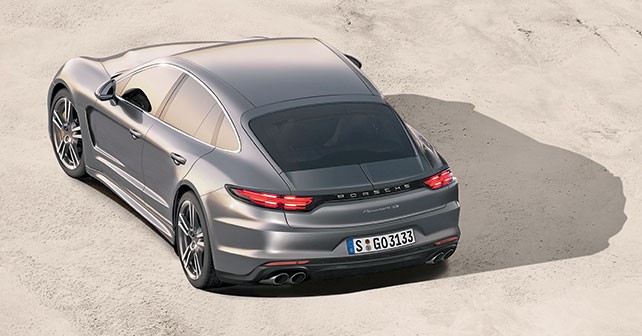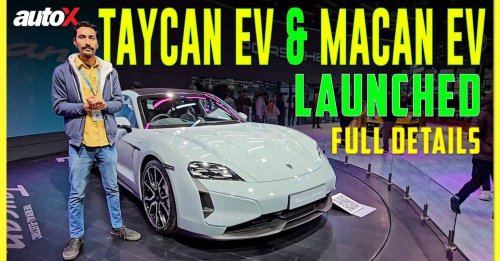
The Panamera has always been a head turner – but not necessarily for the right reasons! Well, the second generation aims to rectify that. Plus, thanks to completely new mechanicals, it’ll be more powerful as well as more frugal.
The new Panamera is going to be lighter, more powerful, but above all, more beautiful than the current model. The detractors of the present four-door coupe from Zuffenhausen might suggest that’s not such a difficult task. And while the styling of the Panamera that was launched in 2009 might have been controversial, Porsche has been able to sell more than 130,000 units of what many believed was an ugly car in less than five years – and that too with a stratospheric price tag. Given such unprecedented success, the potential customers who are expected to approach Porsche dealers towards the end of 2016 with a lot of impatience (and loaded wallets) should be able to see the DNA of the outgoing model. That’s why several websites, while commenting on the photos of the first camouflaged prototypes already on the road, started talking about evolutionary design language rather than a revolutionary step.
SHOOTING BRAKE?
Whatever has been said is only partially true though. Because the way in which the designers, led by Michael Mauer, reinterpreted the features of the Panamera has changed its final perception. Its dimensions remain similar – width is slightly increased, the track is wider, and the total length has increased by a few centimetres. There are, however, rumours about a shooting brake variant. That apart, the flow of the lines and the way both the side and rear are treated provides a certain elegance that’s missing in the current model.
MISSION LIGHTNESS
A few accurate pencil strokes – which have raked the rear windshield further and enabled it to join the roof in a continuous curve, without featuring the step as in the current model – have been enough to lighten up the rear. To create a feeling of harmony, there’s a more slender profile and the tip of the C-pillar forms a vertical line that passes through the centre line of the rear wheel arch (as has been done in every iteration of the 911 since 1963). In this way, the Panamera stays true to Porsche’s brand identity.
This lightness is not an optical illusion. The new four-door coupe had been put on a diet – in line with a new platform that Porsche has created from scratch. Named MSB, it’s a flexible and light platform (it’ll also be used in the Bentley Continental range, as well as for the Pajun – the younger sibling of the Panamera, which is scheduled for a 2017 launch). Thanks to the use of a mix of materials, from high-strength steel to aluminium – of which there’s a lot – and composites, the result is a 100kg saving in terms of weight, despite increased equipment levels.
DIESEL HYBRID
The new architecture will eventually make all-wheel drive and a diesel engine compatible together. It’s logical to expect that the latter (a V6 manufactured by Audi, as always) will also be used in a plug-in hybrid variant, along with the electric-petrol version. After all, the new Audi Q7 features the same solution. As for petrol engines, there will be V6 and V8 engines with power levels superior to the current ones – developed in-house by Porsche – in combination with the seven-speed dual-clutch transmission. We’ll have to wait for the new nine-speed transmission.
WORK IN PROGRESS – CAYENNE III
It’s been the boldest challenge, as well as the most surprising success. The Cayenne, since the launch of its first generation in 2002, changed the perception of Porsche as a brand – overcoming the combined sales figures of the 911, the Cayman, and the Boxster. The second generation was launched in 2010, and last year Porsche gave it a facelift along with several technical innovations (the debut of the 3.6 litre twin-turbo V6 engine with 420bhp, and of the first plug-in hybrid version). Porsche engineers are presently working on the third generation of the car, expected in 2017.
From a styling point of view, the Cayenne could see a further evolution toward appearing sportier still – with some cues coming from the smaller Macan. Mechanically, the next-gen Cayenne is based on the new MLB architecture for longitudinal engines by the Volkswagen group, which has just made its debut in the new Audi Q7. It’ll also form the platform for the Bentley Bentayga SUV and Lamborghini Urus, as well as the Volkswagen Touareg. A plug-in version is confirmed as well.
The third generation of the popular SUV could be the right occasion to launch a coupe version to take on the likes of the BMW X6 and the Mercedes GLE Coupe. After all, if Porsche can’t succeed in this mission – who can?
Here’s a rendering of the 2017 Cayenne. The dimensions are similar, but the design points to a lighter and more dynamic vehicle than the current model
The second generation of the Panamera remains recognisable, but it becomes far more slender in shape
© Riproduzione riservata


























Write your Comment